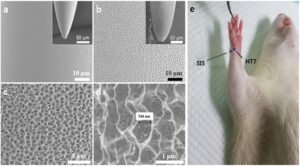Nanoporous Acupuncture needle for enhanced results
Kristen Sparrow • May 25, 2022

I mentioned this needle before. I am keenly interested in it, because of my hunch that there is something about the actual needling, the micro injury, that is key to acupuncture effect beyond just stimulating underlying nerves. They set a cascade of transmitters into motion. This is one reason that I don’t use Seirin needles that are “painless” with less drag. I use basic Chinese needles because I think that the inherent rough quality is important for results. Yes, there is is a bit more bleeding, but that, too, I think is evidence of better signaling. Keep in mind that in this study, manual acupuncture was used, no electrical stim.
I’m attending an International Neuromodulation Society meeting where one of the presentations was about new electrodes that use “heirarchical” construction. This is a process where the basic electrode has nodes upon nodes upon nodes so that the electrical surface area is much higher, allowing for smaller electrodes. Smaller electrodes can be key in invasive Neuromodulation procedures.
It makes me wonder if one could devise a better acupuncture needle to increase tissue reaction. I don’t think this would make needles more painful, but I could be wrong of course.
Lee BR, Kim HR, Choi ES, Cho JH, Kim NJ, Kim JH, Lee KM, Razzaq A, Choi H, Hwang Y, Grimes CA, Lee BH, Kim E, In SI. Enhanced Therapeutic Treatment of Colorectal Cancer Using Surface-Modified Nanoporous Acupuncture Needles. Sci Rep. 2017 Oct 10;7(1):12900. doi: 10.1038/s41598-017-11213-0. PMID: 29018212; PMCID: PMC5635022.
https://www.ncbi.nlm.nih.gov/pubmed/29018212
Abstract
Acupuncture originated within the auspices of Oriental medicine, and today is used as an alternative method for treating various diseases and symptoms. The physiological mechanisms of acupuncture appear to involve the release of endogenous opiates and neurotransmitters, with the signals mediating through electrical stimulation of the central nervous system (CNS). Earlier we reported a nanoporous stainless steel acupuncture needle with enhanced therapeutic properties, evaluated by electrophysiological and behavioral responses in Sprague-Dawley (SD) rats. Herein, we investigate molecular changes in colorectal cancer (CRC) rats by acupuncture treatment using the nanoporous needles. Treatment at acupoint HT7 is found most effective at reducing average tumor size, β-catenin expression levels, and the number of aberrant crypt foci in the colon endothelium. Surface modification of acupuncture needles further enhances the therapeutic effects of acupuncture treatment in CRC rats.
Here is another report of the same article.
“The PN fabricated using an anodization voltage of 20 V shows an estimated surface area of 1.03 m2∙g−1, a maximum value approximately twenty-five times higher than CN (0.04 m2∙g−1). Due to its optimal surface area 20 V PN (nano porous needle) is employed for the majority of investigations within the present work.”
porous needle) is employed for the majority of investigations within the present work.”

